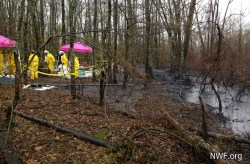
National Wildlife FederationCleanup crews at a marsh covered with oil from the Mayflower spill in April.
The pipeline spill that flooded Mayflower, Ark., with up to 290,000 gallons of tar-sands oil in March was an accident that had been waiting to happen — for more than 60 years.
The pipeline that ruptured beneath the town was defective, with manufacturing flaws going undetected since it was laid in the 1940s, according to independent laboratory tests. ExxonMobil released a short summary of test results Wednesday.
The findings bring into question the integrity of the entire Pegasus pipeline system — and other oil pipelines that crisscross the nation. The Pegasus system, which runs from Illinois to Texas, was laid in 1947 and 1948. The pipeline manufacturer, Ohio-based Youngstown Sheet and Tube Co., is no longer in business but was reportedly one of the leading suppliers of pipelines in the 1940s.
The Pegasus pipeline remains shut down following the spill. Cleanup efforts are still underway. ExxonMobil is being sued over the spill by the federal and state governments.
From ExxonMobil’s press statement about the lab results:
Based on the metallurgical analysis, the independent laboratory concluded that the root cause of the failure can be attributed to original manufacturing defects — namely hook cracks near the seam.
Additional contributing factors include atypical pipe properties, such as extremely low impact toughness and elongation properties across the ERW [electric resistance welded] seam.
There are no findings that indicate internal or external corrosion contributed to the failure.
A seam is the welded part of a pipeline, either running along its spine or holding two pieces of piping together. By the American Petroleum Institute’s definition, a hook crack is caused by flaws at the edge of the metal plate used to create sections of pipeline.
The lab tests were required [PDF] by the Pipeline and Hazardous Materials Safety Administration (PHMSA), but the agency did not release the full results, nor did it comment to the press, citing the ongoing investigation. All we got was ExxonMobil’s five-paragraph statement summarizing the results.
Based on the laboratory findings, though, PHMSA officials will likely want to scour ExxonMobil’s records to determine which other sections of pipeline were provided by the same manufacturer, and find out where else the manufacturer’s pipelines are still being used in the vast networks that snake through the nation.
PHMSA will also be asking questions about Exxon’s apparent failure to adequately test the line when it was installed, or to detect the flaws during tests in more than six decades of operations since.
The pipeline was last inspected in February, but the company is not releasing the results publicly, claiming that would reveal trade secrets. (Yes, the old trade secrets excuse again.)
Electric resistance welded pipe like that which tore open beneath Mayflower has welding along its spine that is particularly vulnerable to rupture. The Pegasus pipeline at Mayflower suffered a 22-foot tear when it burst. From PHMSA’s website:
A failure in the weld seam of this type of pipe can propagate for a distance along the pipe and can quickly release large quantities of product to the environment. Low-frequency (LF) ERW pipe installed prior to 1970 in particular can be susceptible to such failures.
The new lab findings call to mind the natural-gas pipeline explosion that killed eight people and destroyed 38 homes in the San Francisco exurb of San Bruno in 2010. Federal investigators found that PG&E’s gas pipeline had welding and manufacturing flaws when it was laid in 1956, causing it to tear open along a faulty seam and explode. PG&E was faulted for failing to inspect the pipeline and was subsequently ordered to inspect and replace pipes throughout its entire gas network.



